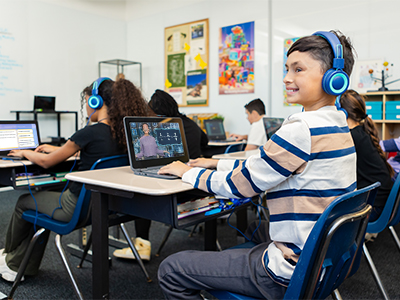Overcoming Obstacles for Discussing AI in the Classroom
Watch the RecordingListen to the Podcast
For many educators, the first response to asking about using AI is, “No, not in our school.” But during the edLeader Panel “AI in Education: Steering Towards Equity and Empowerment,” experts explained why AI shouldn’t be automatically shunned and, instead, should be viewed as another powerful tool in an educator’s arsenal.
Obstacle: AI is a new, untested technology that shouldn’t be in the classroom yet.
On the contrary, many tools already used in the classroom and students’ daily lives, like Google Search, have AI components. AI is just another technology used to augment learning. Like any other digital tool, its benefit to the students depends on how well the teachers incorporate it into lessons and how proficient students become at using it.
Obstacle: AI creates further inequities in the classroom.
While inequities do exist over access to and integration of digital tools, learning how to properly use AI will benefit students. The panelists posited that AI will most likely be part of students’ future careers, so it’s best for them to learn how to use it now. If they don’t, they will experience issues when they are looking for work in the future.
Obstacle: AI provides biased information.
As with all systems developed, vetted, and used by humans, AI does have inherent biases. Since many AI programs are gathering as much information as they can, even from social media, there is a propensity for skewed and unfair results. However, that’s where media literacy education for the students and educators comes in. Knowing that search results from many sources—not just AI—present biases, students can learn how to revise their prompts to reduce the bias. In addition, educators and students can discuss how to evaluate sources and credit them, so that students can select the best information to use in their work.
Obstacle: AI makes students lazy writers.
Actually, according to the panelists, AI can make students better writers. That’s because they are writing the prompts to get the information they need. When the results aren’t satisfactory, they need to further refine their prompts. Furthermore, when integrated into the lessons, the goal is not for AI to write the answers for students but to help them find the information they need so they can develop their own content.
Obstacle: AI depersonalizes learning.
In reality, AI has the potential to enhance personalized learning. With a digital platform, for instance, it’s not possible for the developers to conceive of and prewrite every possible student situation. When AI helps drive the platform, though, it can provide immediate feedback to the child and determine what they need to work on next, in what format, at what level, etc. And, teachers can review all of the data from student learning sessions to gain deeper insights into their students’ progress. In other words, AI becomes another tool that generates data to help teachers teach students.
Obstacle: It’s too hard to figure out which AI tools are worth the investment.
As with any educational tool, educators should go through the school/district-approved vetting process. But more importantly, remember that AI does not replace the pedagogy, user experience, and other factors that you need to evaluate. When adopting new tools, look for evidence-based methodologies used for developing the product and the efficacy results, especially for student populations similar to your own.
Obstacle: None of the teachers will use it.
As with any new tool, look for the early adopters—the ones who understand AI and are ready to implement it. Let them pilot AI in their classrooms and then share their results with their colleagues. Also, it’s important to give your faculty time to play with AI and let them become comfortable with it.
Panelist Alana Winnick, Educational Technology Director and Data Protection Officer for Pocantico Hills Central School District (NY), closed by reminding educators that they need to set the parameters for how AI is used in their classrooms, tailoring its use for each assignment. Last, she explained how she instructs students to think of themselves as having two roles when working with AI. First, they are detectives, looking for the bias and credibility in the information generated by AI. Then, they become DJs, remixing the information and putting their own spin on it to create a new work.
Learn more about this edWeb broadcast, AI in Education: Steering Towards Equity and Empowerment, sponsored by Age of Learning.
Watch the RecordingListen to the Podcast
Join the Community
Artificial Intelligence in Education is a free professional learning community where educators can hear from a range of experts, developers, and solution providers on this fast-developing new technology that will have an unprecedented impact on human life.
Age of Learning® is the leading education technology innovator, creating engaging and effective learning resources to help children build a strong foundation for academic success and a lifelong love of learning. Our research-based digital education programs have been developed by an experienced team of education experts and have proven efficacy in increasing children’s learning gains. The company’s school solutions programs include My Math Academy®, an adaptive, personalized program proven to significantly accelerate math learning outcomes, and My Reading Academy™, an adaptive program designed to help young learners build a foundation for reading comprehension and literacy and become fluent readers. With over 10 billion learning activities completed by more than 50 million children worldwide, Age of Learning is a global leader in efforts to advance equity, access, and opportunity for all children. To learn more about Age of Learning, visit www.AgeofLearning.com.
Article by Stacey Pusey, based on this edLeader Panel





Comments are closed.